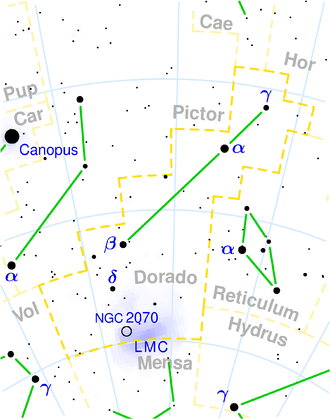NGC 1706
| Galaxy NGC 1706 |
|
|---|---|
![NGC 1706 with LEDA 177963 [1] Hubble space telescope](https://upload.wikimedia.org/wikipedia/commons/thumb/2/2f/NGC1706_-_HST_-_Potw1943a.tif/lossy-page1-300px-NGC1706_-_HST_-_Potw1943a.tif.jpg)
|
|
| NGC 1706 with LEDA 177963 Hubble Space Telescope | |
| AladinLite | |
| Constellation | Swordfish |
|
Position equinox : J2000.0 , epoch : J2000.0 |
|
| Right ascension | 04 h 52 m 31.02 s |
| declination | -62 ° 59 ′ 08.8 ″ |
| Appearance | |
| Morphological type | SA (s) from |
| Brightness (visual) | 12.8 mag |
| Brightness (B-band) | 13.6 mag |
| Angular expansion | 1.4 ′ × 1 ′ |
| Position angle | 124 ° |
| Surface brightness | 13.0 mag / arcmin² |
| Physical data | |
| Affiliation | SSRS group 11 LGG 125 |
| Redshift | 0.016308 ± 0.000087 |
| Radial velocity | (4889 ± 26) km / s |
|
Stroke distance v rad / H 0 |
(210 ± 15) · 10 6 ly (64.4 ± 4.5) Mpc |
| history | |
| discovery | John Herschel |
| Discovery date | December 25, 1837 |
| Catalog names | |
| NGC 1706 • PGC 16220 • ESO 085-007 • 2MASX J04523101-6259089 • SGC 045203-6304.0 • GC 938 • h 2682 • GALEX ASC J045231.34-625909.0 • LDCE 357 NED002 | |
NGC 1706 is a spiral galaxy of Hubble type Sab in the constellation Dorado at the southern sky . It is estimated to be 210 million light years away from the Milky Way and about 90,000 light years in diameter . Together with NGC 1771 and PGC 16670 , it forms the small galaxy group LGG 125 .
The object was discovered by the astronomer John Herschel on December 25, 1837 using his 18.7-inch mirror telescope.
NGC 1706 group ( LGG 125 )
| Galaxy | Alternative name | Distance / million ly |
|---|---|---|
| PGC 16670 | ESO 85-038 | 208 |
| NGC 1771 | PGC 16472 | 215 |
| NGC 1706 | PGC 16220 | 210 |
